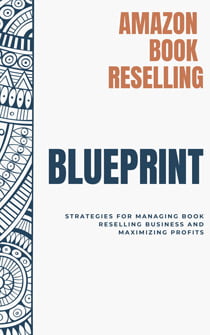The Ultimate Guide to Selling Books on Amazon: Navigating the Barcode Jungle

The Guide to Navigating Amazon's Barcode Jungle When Selling Books on Amazon
Navigating the complex terrain of Amazon’s marketplace can be a daunting task, especially for book sellers aiming to maximize their sales and efficiency. When selling books on Amazon, understanding the myriad of barcode numbers – from ASIN to ISBN, and SKU to FNSKU – is crucial. This guide serves as a comprehensive walkthrough, aimed at demystifying these essential components and offering strategic insights for leveraging them effectively. If you want to learn more about why selling books on Amazon is the ideal way to kickstart your Amazon journey, check out this blog post.
Understanding ASIN for Book Resellers
The Amazon Standard Identification Number (ASIN) is a unique code assigned by Amazon to each product listed on its platform, serving as a crucial identifier for tracking and managing listings. For booksellers, it’s important to note that while we deal with books, we typically do not create new ASINs. This is because books are published by publishers who, or their designated vendors, often list these books on Amazon, thus establishing the ASIN.
When it comes to selling books on Amazon, our role involves listing our inventory under existing listings rather than creating new ones. This approach aligns with best practices for several reasons. Primarily, existing listings for books usually already have established traffic, which significantly increases the visibility and sales potential of our inventory. Creating a new listing for a book that already has an existing ASIN is not only unnecessary but could also reduce the likelihood of attracting customer attention due to the absence of established traffic.
Having grasped the importance of ASINs as our unique identifiers within Amazon’s ecosystem, let’s broaden our understanding to what makes products identifiable on a global scale. Moving on, we will delve into EAN & UPC: identifiers that transcend the Amazon platform, offering a glimpse into a larger system of global product identification.
EAN & UPC: What Booksellers Need to Know
In the world of retail, EAN (European Article Number) and UPC (Universal Product Code) serve as the backbone of product identification and tracking. These barcode standards are universally recognized across the globe for retail packaging. The EAN (European Article Number) known as International Article Number (even though the acronym EAN has been retained), is a broader system used to identify a wide range of products for retail scanning at the point of sale, not limited to books. However, for booksellers operating on Amazon, the interaction with EAN and UPC numbers is minimal.
The reason behind this is straightforward: as booksellers, we are not in the business of manufacturing items. Much like we do not generate new ASINs for our listings, we also do not create or purchase EAN or UPC numbers for the books we intend to sell. These tasks are typically reserved for manufacturers or publishers who are introducing new products to the market.
Understanding the difference between EAN and UPC numbers is beneficial for a comprehensive grasp of global retail operations. Yet, for booksellers, our primary focus is on a different kind of identifier: the ISBN. This unique code functions as a specific type of EAN designed exclusively for identifying books worldwide. It is crucial to recognize that, as booksellers, we also do not create ISBN numbers; instead, we utilize them to list when selling books on Amazon.
As we pivot towards the next chapter, we will delve deeper into the ISBN number specifications, which the ISBN provides all the necessary information for listing and selling books.
Decoding ISBN: The Backbone of Book Identification to Sell Books on Amazon
ISBN, or International Standard Book Number, is a critical tool in the realm of bookselling, coming in two key formats: ISBN-10 and ISBN-13. The introduction of the 13-digit ISBN in January 2007 marked a significant shift, aimed at expanding the capacity of the ISBN system to accommodate an ever-growing number of publications.
For booksellers, the most crucial skill is not converting between these two formats but rather being able to accurately recognize and work with both ISBN-10 and ISBN-13 numbers. This expertise is vital for tracking, listing, and managing book inventories efficiently. Most books display their ISBN, along with its designated barcode, on the back cover, allowing sellers to easily scan and retrieve information about the book in hand. Additionally, leveraging tools such as the Bookzy Mobile book scouting app can further enhance the efficiency of book resellers by providing instant access to valuable data metrics and insights while on the go when selling books on Amazon.
Importantly, the ISBN functions as a type of European Article Number (EAN). In the early 2000s, the ISBN system was harmonized with the EAN system, which is why books now feature an EAN barcode on the back. This 13-digit barcode begins with the prefix ‘978’ or ‘979’, indicating the product category as a book, followed by the digits that represent the ISBN-10. This alignment ensures that books are seamlessly integrated into the global retail system, facilitating their distribution and sale alongside other products.
Unraveling the Relationship Between ASIN and ISBN
Understanding the relationship between ASIN (Amazon Standard Identification Number) and ISBN (International Standard Book Number) is crucial for booksellers. This connection is not merely fundamental but also strategic, significantly influencing the efficiency and accuracy of listing books on the platform.
The Symbiosis of ASIN and ISBN-10
Amazon’s approach to assigning ASIN numbers for books demonstrates a harmonious alignment with ISBN-10 numbers. Given that both ASINs and ISBN-10 numbers consist of 10 characters, Amazon has devised a system where the ASIN for most books listed on its platform directly corresponds to the book’s ISBN-10 number. This thoughtful design simplifies the listing process for booksellers.
However, situations arise where a book’s ASIN does not match any ISBN-10 number. These are usually secondary listings created after the first, often implying that the original listing would potentially attract more traffic. This highlights the critical importance of choosing the correct listing to optimize a book’s visibility and sales potential.
Navigating Multiple Listings with ASIN and ASR
Encountering multiple listings for the same book is a common scenario while selling books on Amazon. Identifying the most appropriate listing is crucial. In most instances, the ASIN number acts as a dependable guide, leading sellers to the original listing. Additionally, assessing the Average Sales Rank (ASR) provides further verification, offering insights into the listing’s performance and popularity.
At this juncture, the value of a specialized listing software for booksellers becomes apparent. An effective listing tool, like Bookz Pro Lister, is essential. It not only displays the ASR but also furnishes sellers with crucial information needed to select the optimal title/listing/ASIN when listing their items. The Bookz Pro Lister boasts numerous features tailored for booksellers, making the selection process for the right title an informed and strategic decision. Check out Bookz Pro Lister to learn more.
The Power of SKU
For an Amazon seller, an SKU (Stock Keeping Unit) is a unique identifier assigned to each product listed for sale. This identifier is used to track inventory and manage stock levels. Unlike universal product codes (UPC, EAN or ISBN in our case), which are standardized and assigned to products globally, SKUs are specific to each retailer or seller and can be customized to fit their inventory system and tracking needs. Utilizing SKUs allows for sophisticated inventory management, enabling you to monitor sales patterns, profitability by sourcing location, and more. Effective use of SKUs can significantly enhance your operational efficiency and financial oversight.
When creating SKUs, Amazon sellers can use a system that makes sense for their business, incorporating information such as product type, category, color, size, and condition, among other attributes. This system helps sellers in various ways:
- Inventory Tracking: Precisely monitor which items are in stock, which need to be reordered, and which are overstocked.
- Order Fulfillment: Efficiently pick and pack orders by quickly locating items in the warehouse.
- Sales Analysis: Analyze sales data with granularity, understanding which items are performing well and why.
- Other: There are many more ways to benefit from a SKU system. Its core purpose is to understand your business’ pain points and be able to track these by formulating SKU.
To further streamline inventory management, consider leveraging the Bookz Pro Stock Manager tool, a game-changing inventory tool tailored for book sellers that helps Use advanced filters and bulk actions for efficient management.
FNSKU: Amazon's Inventory Tracker
FNSKU stands for Fulfillment Network Stock Keeping Unit. It’s a unique identifier used by Amazon for products that are stored in and FBA fulfillment centers. When a seller decides to use FBA service, each item they send to an Amazon fulfillment center is given an FNSKU. This identifier allows Amazon to track the item throughout its fulfillment process, ensuring that the correct product is sent to the customer who ordered it.
The FNSKU is specific to the seller and the product. It means that if different sellers list the same product under FBA, each will have a unique FNSKU for that product. This system helps Amazon manage and fulfill orders with high accuracy and efficiency, as it ties each product directly to the seller’s inventory in Amazon’s system.
When selling books on Amazon, it’s not necessary for us to know much more about FNSKU beyond its basic purpose and usage. This label is what we apply to our books when listing an item through FBA. Essentially, there isn’t much else concerning FNSKU that is relevant to booksellers.
Conclusion
In conclusion, mastering Amazon’s complex system of identifiers—ASIN, ISBN, SKU, and FNSKU—is crucial for any bookseller looking to thrive. These codes are more than mere labels; they’re keys to unlocking your inventory’s visibility and sales potential on this vast platform. By effectively utilizing these identifiers and embracing tools like specialized listing software, booksellers can streamline operations and enhance their success. Remember, understanding and leveraging Amazon’s barcode jungle is your path to navigating the competitive world of online bookselling with confidence and efficiency.
In addition, we have created a free eBook called “Amazon Book Reselling Blueprint” that you can download. If you are a bookseller on Amazon, you may find our all-in-one software for book sellers helpful.

Amazon Book Reselling Blueprint
Read now, explore our full guide. Your revolution starts here. Subscribe to get the blueprint!



